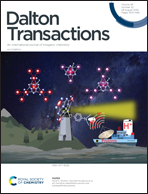Roles of basicity and steric crowding of anionic coligands in catechol oxidase-like activity of Cu(ii)–Mn(ii) complexes†
Abstract
Five new heterometallic Cu(II)–Mn(II) discrete trinuclear complexes, [(CuL)2Mn(CH3COO)2] (1), [(CuL)2Mn(NO3)2] (2), [(CuL)2Mn(C6H5COO)(H2O)]Cl (3), [(CuL)2Mn((p-OH)C6H5COO)(H2O)]ClO4 (4) and [(CuL)2Mn(HCOO)(H2O)]ClO4 (5), have been synthesized using a metalloligand, CuL derived from an N2O2 donor Schiff base, H2L (N,N‘-bis(α-methylsalicylidene)-1,3-propanediamine). Single-crystal structural analyses reveal that all five complexes have a common [(CuL)2Mn] core, where two terminal metalloligands, CuL, are connected to the central metal ion, Mn(II), via double phenoxido bridges. Among the complexes, 1 and 2 possess linear structures where the terminal Cu(II) atoms are bridged to the central Mn(II) atoms by acetate and nitrate ions, respectively along with the double phenoxido bridges, whereas 3, 4 and 5 have bent structures in which the respective anionic coligands, benzoate, p-hydroxybenzoate and formate ions are coordinated only to central Mn(II) in monodentate fashion along with a water molecule that completes its hexa-coordinated geometry. Among the complexes, 1, 3, 4 and 5 show quite high bio-mimicking catecholase-like activity for the aerial oxidation of 3,5-di-tert-butylcatechol with turnover numbers (Kcat) of 139 h−1, 439 h−1, 348 h−1 and 730 h−1, respectively, whereas complex 2 is practically inactive towards this reaction. The presence of the coordinated water molecule to Mn(II) in the bent complexes, 3–5, appears to be responsible for their high catalytic activity and the difference in their activity may be attributed to steric crowding due to the anionic coligand, whereas the inactivity of 2 seems to be associated with the low basicity of the nitrate ion. The temperature-dependent dc molar magnetic susceptibility measurements reveal that complexes 1–5 are antiferromagnetically coupled with the exchange coupling constants (J) = –8.54 cm−1, −11.50 cm−1, −19.83 cm−1, −10.65 cm−1 and −10.27 cm−1 for 1, 2, 3, 4 and 5 respectively as is expected from the Cu–O–Mn bridging angles.



 Please wait while we load your content...
Please wait while we load your content...